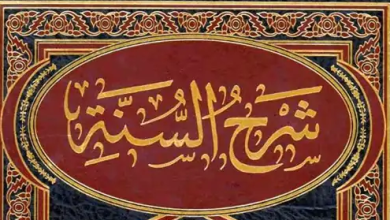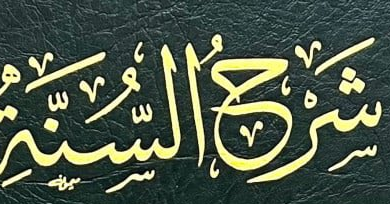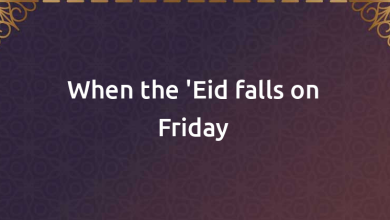The Status of Imam Abu Hanifah in the Science of Hadith
Translator’s Preface
The following is a brief, yet comprehensive, explanation of the rank of Imām Abū Hanīfah in the science of Hadīth. As was mentioned earlier, this is an excerpt from the previous section of our abridged translation of Athar al-Hadīth al-Sharīf fī Ikhtilāf al-A’immah al-Fuqahā’.
In this excerpt, the author commences by differentiating between the amount of hadiths a scholar knew and the amount he imparted; the latter does not reflect the exact amount of the former. Just as the knowledge of Abū Bakr (Allāh be pleased with him) cannot be gauged at by the amount of hadīths he narrated, likewise, Imām Abū Hanīfah cannot be labelled as one who knew very few hadiths simply because he narrated a limited amount hadiths.
One can understand the amount of hadiths Imām Abū Hanīfah knew by the fact that he is accepted by scholars as a mujtahid, and one of the prerequisites to reach the ranks of ijtihād is to know thousands of hadiths as mentioned by Imām Ahmad and Imām Yahyā ibn Ma‘īn. Accordingly, Imām Abū Hanīfah was aware of that amount of hadiths if not more.
Thereafter, the author discusses the academic status of Kūfah by citing the influence of ‘Abd Allāh ibn Mas‘ūd and his students upon its inhabitants, such that ‘Alī mentions he has filled it with knowledge and understanding. He then follows this by proving the encompassing knowledge Imām Abū Hanīfah acquired from the scholars of Kūfah. He further explains that his knowledge was not confined to what he learnt from his townsmen; rather, he was well versed with the knowledge of Makkah, Madīnah, and other Islāmic cities, by virtue of his frequent travels to the holy cities during Hajj and his stay there for several years.
In conclusion, the author briefly mentions several scholars who in recent times have penned works regarding the status of Imām Abū Hanīfah in the science of Hadīth, among whom is the erudite scholar of Hadīth, ‘Allāmah Zafar Ahmad al-‘Uthmānī.
It should be remembered this is only an abridged translation. Therefore, several sections have been omitted and others were summarized. To make the article more-reader friendly, an idiomatic translation was adopted in many places. Those who are interested in more detail are advised to read the original work.
Muntasir Zamān
————————————————————————————————————————————————————————-
The Status of Imām Abū Hanīfah in the Science of Hadīth
By Shaykh Muhammad ‘Awwāmah
Translated by Muntasir Zamān
From one angle, the science of Hadīth is reception, and from another angle, it is transmission. Firstly, a Hadīth scholar learns the narration from his teachers, which is termed as “tahammul,” after which he imparts it to others, which is termed as “adā’.” When he narrates excessively, people become aware of his narrations, which in turn serve as an expression of his abundant reception [i.e. of Hadīth]. Conversely, when he is preoccupied with other than the transmission of Hadīth, whatever he narrates occasionally will not represent the amount of his reception [i.e. of Hadīth], be it minimal or excessive.
Abū Bakr (Allāh be pleased with him) was the first man to accept Islām, the most constant in the companionship of the Prophet (peace and blessings be upon him), and the most knowledgeable Companion. In spite of this, only a fraction of his narrations have reached us, which do not portray that he was from the scholars of the Companions, let alone portray that he was the most knowledgeable of them. Similar is the case of our masters, ‘Umar, ‘Uthmān, and ‘Alī and other Companions as well as a large number of Successors and their successors (al-tābi‘ūn wa atbā‘uhum).
In fact, you can say the same for Imām Mālik whose prominence in Hadīth is as his student al-Shāfi‘ī explains, “When it comes to Hadīth, Mālik is the star.” He himself says, “I have written one hundred thousand narrations.”[1] Likewise is the case of Imām al-Shāfi‘ī, regarding whom Imām al-Subkī writes, “Ibn Khuzaymah was asked, “Do you know any Sunnah regarding halāl and harām which al-Shāfi‘ī did not include in his books?” He replied, “No.”[2] [i.e. authentic Sunnah from the Ahādīth of legal injunctions, and not Ahādīth in general.]
Imām Mālik and al-Shāfi‘ī can be excused [for not narrating everything they knew] on account of their preoccupation with fiqh, imparting fiqh, ijtihād, deducing rulings, and laying out the principles of fiqh and ijtihād more than the transmission of Hadīth. This does not mean that they had scarce knowledge of Hadīth; rather, they were abundant in reception and infrequent in transmission.
Imām Abū Hanīfah’s situation was identical: he was abundant in reception and infrequent in transmission, to which Hāfiż Ibn Hajar from the latter-day authorities has attested. When asked whether Imām al-Nasa’ī’s critique on Imām Abū Hanīfah was correct and accepted by other scholars, he responded:
Al-Nasa’ī was from the scholars of Hadīth. His remarks were based on his judgment and what was apparent to him. No individual is such that his every opinion is accepted. A group of hadith scholars have concurred with al-Nasa’ī in speaking about him. Al-Khatīb in his Tārīkh under his entry has encompassed all of their statements, among which are those that will be accepted and those that will be rejected.
The Imām has been excused because he was of the opinion that he will only narrate what he has memorized from the time he heard it until he imparted it, due to which transmission from him was minimal. His narrations were minimal in relation to this; otherwise, in reality he knew many narrations.
In brief, it is best to refrain from such discussions because the Imām and his likes have crossed the bridge and thus no statement will affect them. Rather, they are in the position where Allah has placed them in that they are leaders who are followed.”[3]
It was for this reason that under the biography of Abū Hanīfah in al-Tahdhīb Ibn Hajar himself did not mention any statement that goes against this in respect to the Imām. Prior to him, al-Mizzi did the same in Tahdhīb al-Kamāl, and al-Dhahabī in al-Siyar, al-Tadhkirah, and in Tadhhīb Tahdhīb al-Kamāl who concluded his entry with the following, “Our teacher Abu al-Hajjāj –i.e. al-Mizzī- did well by not mentioning anything that would necessitate weakness [on the part of Imām Abū Hanīfah].”[4]
The following incidents bear clear witness to this testimony [i.e. he knew many Ahādīth]:
Yahyā ibn Nasr says, “I came to the house of Abū Hanīfah and it was filled with books, so I asked, “What is this?” He responded, “These are all Ahādīth. I have narrated but a few by which people may benefit.”[5] Muhammad ibn Samā‘ah mentions, “Abū Hanīfah mentioned over seventy thousand Ahādīth, and selected only forty thousand Ahādīth for the compilation of al-Āthār.”[6]
A person asked Imām Ahmad, “When a person memorizes one hundred thousand Ahādīth, will he be regarded as a jurist?” He responded, “No.” The questioner then asked, “What about two hundred thousand?” He responded, “No.” He asked, “What about three hundred thousand?” He responded, “No.” He asked, “What about four hundred thousand?” In response, Imām Ahmad made a hand gesture i.e. perhaps he is qualified to be mujtahid jurist who can pass verdicts.[7] Yahyā ibn Ma‘īn mentions that a person who memorizes five-hundred thousand Ahādīth might be qualified to exercise ijtihād and pass verdicts.[8]
The contemporaries of Imām Abū Hanīfah and those after him have attested to the fact that Abū Haniīfah was a jurist and mujtahid. In fact, everyone is dependent on him with regards to fiqh. Therefore, it is evident that he gathered this amount and much more.
Imām Ahmad, who makes it conditional for a person to know such a large number of Ahādīth to be qualified for ijtihād, is among those prominent Imāms who praised Imām Abū Hanīfah, as mentioned by ‘Allāmah al-‘Aynī in al-Bināyah.[9] Al-Tufī al-Hanbalī writes:
In brief, he [Imām Abū Hanīfah] certainly did not oppose the Sunnah out of stubbornness. Whatever he went against was based on ijtihād due to clear proofs and suitable evidences, which are available to people. Very few of his opponents were just in their assessment. If he erred, he will receive one reward, and if he was correct, he will receive two rewards. Those who criticize him are either jealous or ignorant concerning the places of ijtihād…The final stance authentically recorded from Imām Ahmad is that he mentioned him positively and praised him.” [10]
Al-Sālihī al-Shāfi‘ī and Ibn Hajar al-Haytamī al-Shāfi‘ī quote al-Zaranjarī as saying, “Imām Abū Hafs al-Kabīr instructed that the teachers of Imām Abū Hanīfah be counted. Thus, there were four thousand Successors (Tābi‘ūn).” Thereafter, al-Sālihī enumerated some of his teachers alphabetically in twenty-three pages, which is a large number seldom found among Imāms who were exclusively engaged in Hadīth.”[11]
Imām Abū Yūsuf mentions, “I have never seen anyone more knowledgeable regarding the commentary of Hadīth than Abū Hanīfah. He had more insight than me regarding authentic narrations.”[12] Imām Abū Yūsuf was that personality regarding whom the Imām of al-Jarh wa al-Ta‘dīl and the king of the Huffāż (expert hadith memorizers) [13] Yahya ibn Ma‘īn said, “Among the Ahl al-Ra’y, I have never seen anyone more reliable in Hadīth, retaining, and authentic in transmission than Abū Yūsuf.”[14] It should be noted that Ibn Ma‘īn never met Abū Hanīfah, so it cannot be said, “Why did he specifically mention Abū Yūsuf and not Abū Hanīfah?”
Imām Abū Yūsuf mentions:
Whenever Abū Hanīfah was determined upon a view, I would go to the scholars of Kūfah in search of a prophetic narration or non-prophetic narration in support of his view. Sometimes I would find two or three narrations, which I would present to him. Regarding some of those narrations, he would say, “This is unauthentic or unknown.”[15]
Kūfah was that place where one thousand five hundred Companions settled and filled with knowledge. Rather, Ibn Mas‘ūd (Allāh be pleased with him) himself filled it with knowledge according to the testimony of ‘Ali ibn Abī Tālib (Allāh be pleased with him). [16] When ‘Alī (Allāh be pleased with him) arrived in Kūfah, Ibn Mas‘ūd (Allāh be pleased with him) and his students came to receive him such that they covered the horizon. When ‘Alī (Allāh be pleased with him) saw them, he remarked, “You have filled this city with knowledge and understanding.” [17]
Imām al-Hākim wrote a specific chapter, i.e. chapter forty-nine, which he commenced with the following, “This chapter of knowledge is knowing the reliable and famous Imāms from the Successors and their successors, whose Ahādīth are gathered for memorization, revision, and attaining blessings from them and by mentioning them, from the east to the west.”[18] Thus, he mentioned forty narrators from Madīnah, twenty-one from Makkah, and two hundred and one from Kūfah, and included Imām Abū Hanīfah among them.
In al-Mustadrak, he narrates the Hadīth, “There is no marriage without a guardian” after which he says, “A group of the Imāms of the Muslims, besides whom we have mentioned, have narrated this Hadīth with continuity via Abū Ishāq, among whom is: Abū Hanīfah…”[19]
Imām Abū Hanīfah gathered the knowledge of the people of Kūfah according to his own testimony, as was mentioned earlier, and the testimony of others. Yahyā ibn Ādam, one of Imām al-Bukhāri’s teacher in his al-Sahīh, says, “Indeed, the Hadīth contain abrogating narrations and abrogated narrations, like the Qur’ān. Imām Abū Hanīfah gathered all the knowledge of his townsmen and thus he saw the final practice of the Prophet (peace and blessings be upon him) and accepted that, by virtue of which he was a jurist.” [20]
Al-Hasan ibn Sālih, a reliable jurist and ascetic, mentions:
Abū Hanīfah was particular about searching for the abrogating narrations (al-nāsikh) and the abrogated narrations (al-mansūkh), so that he may practice upon what is established from the Prophet and his Companions. He was well versed with the narrations and fiqh of the people of Kūfah, and was a staunch adherent of the practice of his townsmen.
He also said, “…He knew the final practice of the Messenger of Allāh (peace and blessings be upon him), upon which he passed away, that reached the people of his city.”[21]
To understand the importance of knowing the injunctions upon which the Prophet (peace and blessings be upon him) passed away, and upon which the law was established, consider the statement of Imām al-Zuhrī, “They [the Sahābah] would search for his [the Prophet’s] final practice, and would regard it as abrogating and definite.”[22]
The knowledge of Imām Abū Hanīfah was not restricted to the narrations of his hometown; rather, he possessed complete knowledge of the narrations of the people of Hijāz. This was during his stay in Makkah when he fled from Kūfah in the year 130 AH due to the persistence of Yazīd ibn ‘Umar ibn Hubayrah that he become a judge, which he refused. He only returned to Kūfah during the reign of Abū Ja‘far al-Mansūr in the year 136 AH. This was not a short period in the life of this mujtahid imam in an academically rich environment such as Makkah, the permanent center of the Islamic world for its scholars and Hadīth experts, and particularly the pilgrims of the sacred house of Allāh every year.
In addition, he performed Hajj fifty-five times; each time, he met with the scholars of Makkah, Madīnah, and the rest of the cities of Islām. It is for this reason that you will find among those teachers al-Sālihī mentioned in ‘Uqūd al-Jumān many teachers from Makkāh, Madīnah, and various other cities.[23]
Moreover, Imām Abū Hanīfah did not permit transmission by ijāzah as was the view of Shu‘bah ibn al-Hajjāj, the Imām of al-Jarh wa al-Ta‘dīl in his era. Shu‘bah said, “If ijāzah was permitted, traveling (for Hadith) would be vain.”[24] Thus, how could Imām Abū Hanīfah restrict himself to the scholars of his city, when traveling for hadith was stipulated?
This is a very length discussion, and I do not wish to prolong any further. In this respect, the erudite scholar, Shaykh Zafar Ahmad al-‘Uthmānī collected quotes that are otherwise not found in one place in his book, Injā’ al-Watan ‘an al-Izdirā’ bi Imām al-Zamān. Thereafter, our teacher, the researcher, Shaykh ‘Abd al-Rashīd al-Nu‘mānī authored a book in this respect entitled, Makānat al-Imām Abī Hanīfa fī al-Hadīth, which was edited and printed by our teacher Shaykh ‘Abd al-Fattāh Abū Ghuddah and he increased with light upon light. Thereafter, an excellent academic study was printed in six hundred pages entitled, “Makānat al-Imām Abī Hanīfah bayn al-Muhaddithīn” by Dr. Muhammad Qāsim al-Hārithī.
After this, do some [academically] crippled people still aspire to taint the reputation of this Imām?
—————————————————————————————————————————–
[1] Al-Qādī ‘Īyād, Tartīb al-Madārik, 121,124:1
[2] Al-Subkī, Ma‘nā Qaswl al-Imām al-Muttalibī, 77,106
[3] Al-Sakhāwī, al-Jawāhir wa al-Durar, 946:2
[4] Al-Dhahabi, Tadhib Tahdhīb al-Kamāl, 225:9
[5] Al-Zabīdī, ‘Uqūd al-Jawāhir al-Munīfah, 31:1
[6] Al-Qārī, al-Manāqib, attached to al-Jawāhir al-Mudī’ah, 474:2
[7] Ibn al-Qayyim, I‘lām al-Muwaqqi‘īn, 1:48
[8] Al-Khatīb, al-Jāmi‘ li Akhlāq al-Rāwī, 174:2
[9] Al-‘Uthmān, Qawā‘id fī ‘Ulūmal-Hadīth, 328
[10] Al-Tūfī, Sharh Rawdat al-Nāżir, 290:3
[11] Al-Sālihī, ‘Uqūd al-Jumān, 63,319; al-Haytamī, al-Khayrāt al-Hisān, 23
[12] al-Haytamī, al-Khayrāt al-Hisān, 24,61
[13] As mentioned by al-Dhahabī in al-Tadhkirah, 465
[14] Al-Dhahabī, al-Manāqib, 40
[15] Ibid., 61
[16] Read: Kawtharī, Fiqh Ahl al-‘Irāq, 40; al-Bannūrī, Ma‘ārif al-Sunan, 252:1
[17] Al-Sarakhsī, al-Mabsūt, 68:16
[18] Al-Hākim, Ma‘rifat ‘Ulūm al-Hadīth, 240
[19] Al-Hākim, al-Mustadrak, 171:2
[20] Al-‘Alā’ al-Bukhārī, Kashf al-Asrār, 16:1
[21] Al-Saymarī, Akhbār Abī Hanīfah wa Ashābih, 11
[22] Muslim, al-Sahīh, 785:2
[23] Al-Sālihī, ‘Uqūd al-Jumān, 64, 220
[24] Al-Suyūtī, Tadrīb al-Rāwī, 256






